Bear has two launches on his site; now I have one!
Bear and Syn gave me a rocket for my birthday, an Estes Stardart. Quite a small, simple rocket, but critically, with a parachute. Bear favours streamers for recovery, while I have usually used parachutes. Parachutes can be a little more reliable in terms of getting the rocket back in one piece, but less reliable in terms of landing anywhere near the launch site.
A famous rocket of over 15 years ago was found about 1km from the launch site, after two teenage boys door-knocked half a suburb saying "Excuse me ma'am, may we search your backyard for a rocket? The rocket is not dangerous but the lizard on board might be." That was an Estes X-Ray, with a lizard on board as Australia's first astronaut. Actually probably astrosaur. Anyway, that rocket (and lizard) were found despite the parachute landing some distance away.
Anyway, on the June long weekend we decided to launch the Stardart. A very calm day was chosen, though it was very overcast which is always a bit risky - you can't see the rockets very well after lauch against a grey sky.
Be that as it may, we set up and launched! The following pictures are frames from the video recorded by Bear...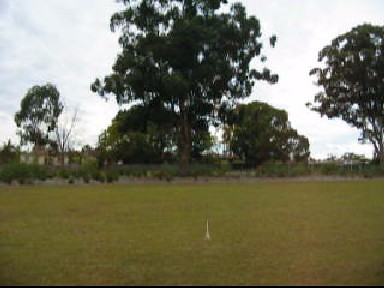 Stardart ready for launch!
Stardart ready for launch!
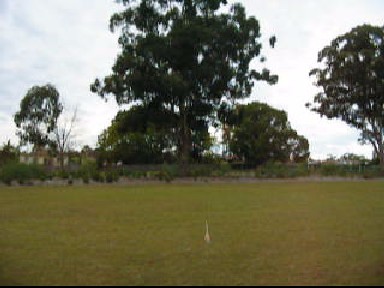 The igniter fires...
The igniter fires...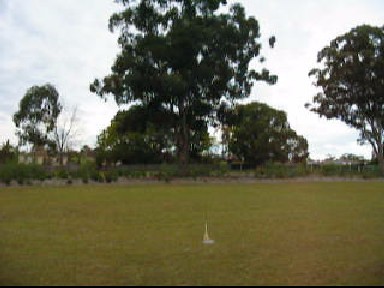 ...triggering the main engine.
...triggering the main engine.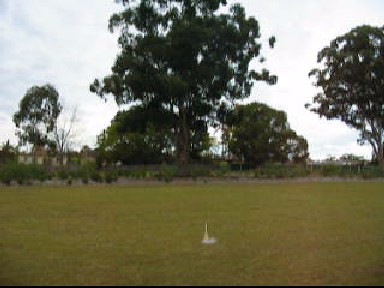 Main engine burning, building up thrust...
Main engine burning, building up thrust...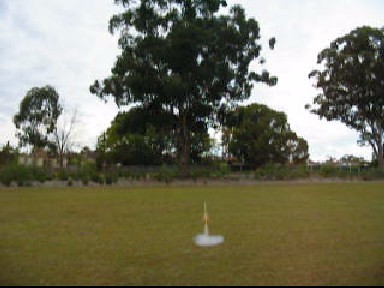 ...resulting in liftoff! Note the flame from the engine lighting up the fins.
...resulting in liftoff! Note the flame from the engine lighting up the fins.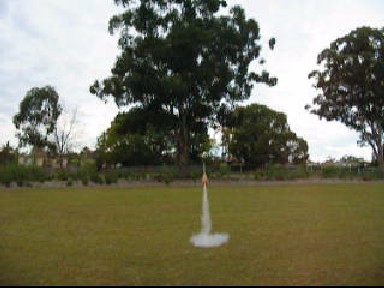 The rocket is accelerating straight up, still on the launch rod. The engine flame is very visible now and seems to be around 100mm long. I think the somewhat dark conditions helped to see the normally invisible flame.
The rocket is accelerating straight up, still on the launch rod. The engine flame is very visible now and seems to be around 100mm long. I think the somewhat dark conditions helped to see the normally invisible flame.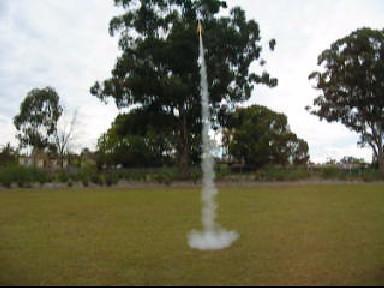 The vehicle has cleared the tower, and commemced it's completely uncontrolled yaw program, caused by a slight wind which wasn't there a few seconds ago.
The vehicle has cleared the tower, and commemced it's completely uncontrolled yaw program, caused by a slight wind which wasn't there a few seconds ago.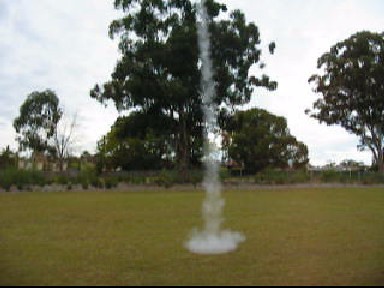 Tracking looses sight of the vehicle. This was pretty much the last we saw of it.
Tracking looses sight of the vehicle. This was pretty much the last we saw of it.
 Stardart ready for launch!
Stardart ready for launch! The igniter fires...
The igniter fires... ...triggering the main engine.
...triggering the main engine. Main engine burning, building up thrust...
Main engine burning, building up thrust... ...resulting in liftoff! Note the flame from the engine lighting up the fins.
...resulting in liftoff! Note the flame from the engine lighting up the fins. The rocket is accelerating straight up, still on the launch rod. The engine flame is very visible now and seems to be around 100mm long. I think the somewhat dark conditions helped to see the normally invisible flame.
The rocket is accelerating straight up, still on the launch rod. The engine flame is very visible now and seems to be around 100mm long. I think the somewhat dark conditions helped to see the normally invisible flame. The vehicle has cleared the tower, and commemced it's completely uncontrolled yaw program, caused by a slight wind which wasn't there a few seconds ago.
The vehicle has cleared the tower, and commemced it's completely uncontrolled yaw program, caused by a slight wind which wasn't there a few seconds ago. Tracking looses sight of the vehicle. This was pretty much the last we saw of it.
Tracking looses sight of the vehicle. This was pretty much the last we saw of it.Lessons learned from this launch:
Lower-power B6-4 engines produce a somewhat more graceful launch. They have a lower overall impulse than the Cs Bear used, resulting in a few more pretty frames of video.
Don't launch against grey skies - you can never see the damn thing for more than about 10m from the ground.
The kit-built Stardart, while heavier than Bear's all-balsa rockets, is considerably more streamlined, with a smooth fuselage and long tapering nose. We suspect this rocket went at least as fast as Bear's C-powered ones, and went possibly higher than any of our previous rockets.
No wind at ground does not necessarily mean no wind aloft... once the parachute deployed this rocket was last seen heading towards Parramatta. A shame, as it was a pretty good rocket, and was quite intact.
Two sepearate search parties went far beyond The Planet Of The Spiders to try to find the Stardart, but to no avail. Both search parties also saw no signs of police, ambulance, fire brigade or military activities, which is something you DON'T want to see after loosing a rocket.
Well, it's raining again, so no rockets this weekend. There are these two leftover B6-4 engines on my desk though... let's see what I can build...
No comments:
Post a Comment